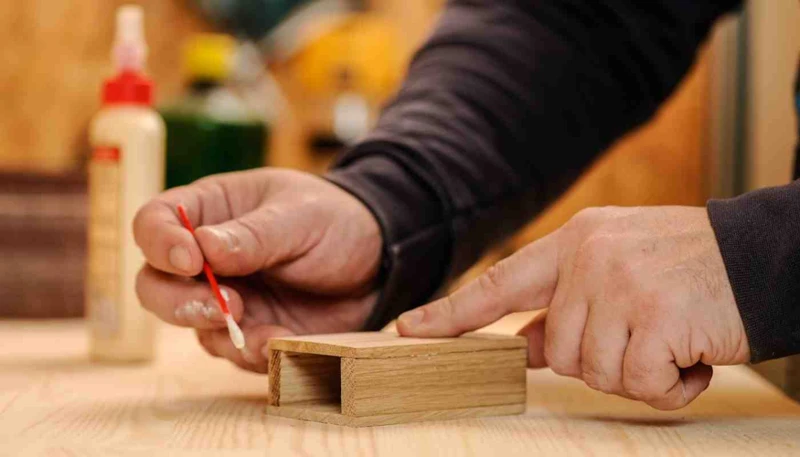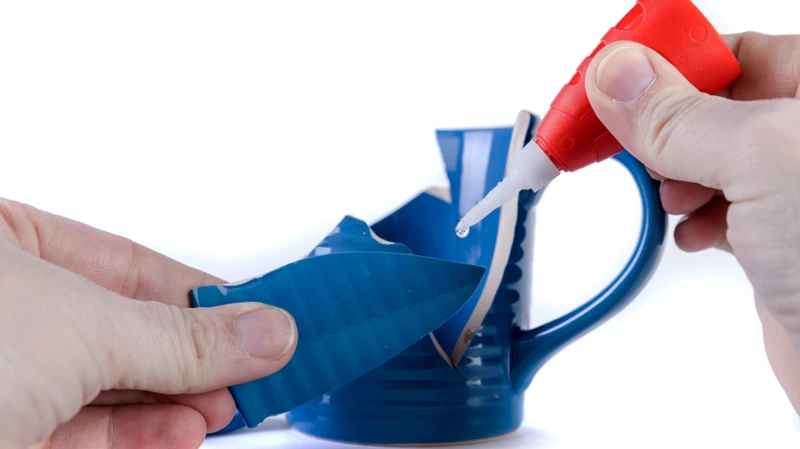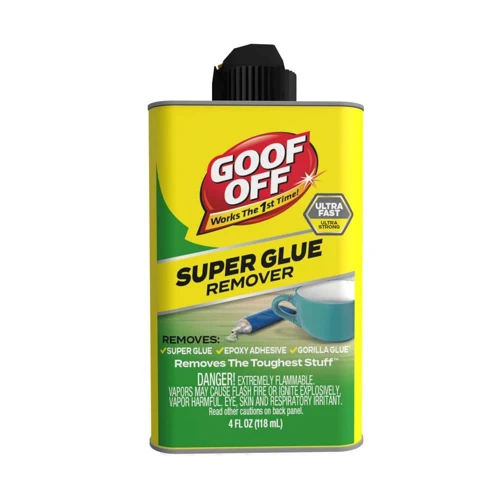Have you ever found yourself struggling to fix a broken item? Whether it’s a broken toy or a cracked dish, it can be frustrating when things don’t work properly. Don’t worry though, because super glue is here to save the day! Super glue is a powerful adhesive that can bond a wide variety of surfaces. But if you’re new to using super glue, you may feel overwhelmed and confused about how to get started. That’s where this beginner’s guide comes in. In this article, we’ll cover everything you need to know about how to use super glue, including the different types, preparation, application, removal, storage, and safety tips. Get ready to become a pro at fixing broken items with super glue!
What is Super Glue?
Super glue is a popular adhesive used for a variety of DIY projects and repairs. It is a strong and fast-acting adhesive that can bond many materials together, making it a useful item to have on hand in any household. While it is commonly known as super glue, it is also referred to as cyanoacrylate glue. In the following sections, we will dive into the types of super glue, how to use it, and how to safely remove it. We will also answer some frequently asked questions and provide safety tips for working with this powerful adhesive. But first, let’s discuss the different types of super glue available. If you want to learn how to fix a broken key with super glue, check out our guide on fixing a broken key with super glue.
Types of Super Glue
When choosing a super glue, it’s important to decide which type is best for your project. Different types of super glue have different formulas and are designed for specific materials. Here are the most common types of super glue:
| Type | Description |
|---|---|
| Cyanoacrylate Super Glue | Cyanoacrylate super glue is the most common type of super glue. It dries quickly and forms a strong bond on most surfaces, including metal, plastic, rubber, and ceramic. The bond is permanent and difficult to reverse. |
| Epoxy Super Glue | Epoxy super glue is a two-part adhesive that must be mixed together before use. It forms a strong bond on a variety of surfaces and can be sanded or painted after it dries. Epoxy super glue is ideal for bonding metal, wood, and concrete. |
| Plastic Super Glue | Plastic super glue is specially formulated to bond plastic surfaces. It dries clear and forms a strong, permanent bond. This type of super glue is ideal for bonding plastic toys, figurines, and other items. |
Before choosing a super glue, check to see what surfaces it is designed to bond and whether it is suitable for your project. Keep in mind that different super glues have different setting times and cure times, so be sure to choose one that works for your application.
It’s also important to note that super glue can be harmful if it comes into contact with skin or eyes. Be sure to take proper safety precautions when using any type of super glue, including wearing protective eyewear and gloves.
If you’re unsure of which type of super glue to use or how to use it properly, check out our guide on how to use CA glue or read the instructions on the package. Additionally, you can find information about how long it takes for Loctite super glue to dry or how long it takes for super glue to dry, which may differ depending on the type and brand of glue.
Preparing to Use Super Glue
Before you start using super glue, it’s important to prepare yourself and your workspace. Rushing into the application process without taking the necessary precautions could lead to a less-than-desirable outcome. It’s always better to take some time to properly prepare before diving in headfirst. In this section, we’ll cover the materials you’ll need to get started and how to properly set up your workspace for optimal results. Let’s get started!
Materials Needed
Before you start applying super glue, you need to make sure you have all the necessary materials. Here’s a list of items you’ll need to get started:
- Super glue: Of course, you’ll need the glue itself. Choose the right type of super glue for the job you’re doing. Different super glues have different bonding strengths and drying times, so be sure to read the label carefully.
- Protective gloves: Super glue can stick to your skin very quickly, so it’s important to wear protective gloves to prevent accidental bonding.
- Safety glasses: Super glue can be a bit fumey, so make sure to wear safety glasses during application.
- Clean cloth: You’ll want a clean cloth handy to wipe away any excess glue that may spill onto surrounding surfaces. Make sure it’s a cloth you don’t mind getting glue on!
- Masking tape: If you’re applying the glue to a vertical surface, you may want to use masking tape to hold the pieces in place while the glue dries.
Having all of these materials within arm’s reach will make the super gluing process much smoother and safer. As with any DIY project, it’s important to take the necessary precautions to avoid accidents and injuries.
Applying Super Glue
Now that you have prepared yourself and gathered all the required materials, it’s time to learn how to apply super glue like a pro! Applying super glue is not rocket science, but it does require precision and care to ensure a strong and secure bond. In this section, we will walk you through the step-by-step guide for applying super glue, along with some tips and tricks to help you get the best results possible. So, get ready to dive in and discover the right way to use super glue!
Step-by-Step Guide
When it comes to using super glue, preparation is crucial to ensure that the application process is both safe and successful. Follow these step-by-step instructions to correctly apply super glue:
| Step | Instructions |
|---|---|
| Step 1 | Clean the surfaces: Before applying super glue, ensure that the surfaces you plan to bond are clean, dry, and free of any dirt, dust, or oil. Use a clean, damp cloth to wipe down both surfaces, then allow them to air dry completely. |
| Step 2 | Apply the glue: Squeeze a small amount of super glue onto one of the surfaces using the applicator. A little goes a long way, so only a small amount is necessary. Be sure to apply the glue evenly and consistently. |
| Step 3 | Join the surfaces together: Gently press the two surfaces together, using light pressure. Hold the surfaces in place for at least 10-30 seconds to allow the glue to set. |
| Step 4 | Allow the glue to dry: Super glue typically dries within a minute or two, but the bonding process can take up to 24 hours to fully cure. Avoid handling the glued area until it has completely dried and cured. |
| Step 5 | Clean up excess glue: If excess glue oozes out of the bonded area, wipe it away immediately using a cloth dampened with acetone. Do not use water or soap to clean up super glue, as this will only make it harder to remove. |
Note: It is important to wear gloves and work in a well-ventilated area when using super glue, as the fumes can be harmful when inhaled. In case of accidental contact with skin or eyes, flush the area with water and seek medical attention immediately.
Tips for Successful Application
When it comes to using super glue, there are a few tips and tricks that can make the application process more successful. Here are some important tips to keep in mind:
| Tip | Description |
|---|---|
| Prepare the surface | Make sure the surface is clean and dry before applying the super glue. This will help the glue adhere better. |
| Apply a small amount | Super glue is strong, so it’s best to apply a small amount to start with and add more if needed. This will help avoid making a mistake and gluing something together that shouldn’t be. |
| Hold the pieces together | After applying the glue, hold the pieces together firmly for at least 30 seconds to ensure a strong bond. |
| Use clamps or tape | If you’re working with a larger or more complex object, using clamps or tape can help hold the pieces together while the glue dries. |
| Don’t apply too much pressure | While it’s important to hold the pieces together firmly, avoid applying too much pressure, as this can cause the glue to squeeze out and make a mess. |
| Store properly | After using super glue, make sure to store it properly so it doesn’t dry out. Most types of super glue should be kept in a cool, dry place. |
By following these tips, you can achieve a successful application of super glue and create a strong bond between two surfaces. Keep in mind that super glue can be difficult to remove once it has dried, so it’s important to take your time and apply the glue carefully.
Removing Super Glue
Removing super glue can be a tricky task, especially if it has dried and hardened on a surface that you don’t want it to stick to. But don’t worry, there are safe and effective methods to remove super glue without causing damage or leaving behind residue. In this section, we will explore different ways to remove super glue, using common household items and tools. So, if you’ve accidentally spilled super glue or want to remove it from a surface, keep reading to learn how to do it the right way.
Methods for Safe Removal
When it comes to removing super glue, there are a few methods you can use that are safe for both your skin and the surface the glue is stuck to. Here are some options:
- Acetone: Acetone is a common ingredient in many nail polish removers. Using acetone to remove super glue is a simple process, but it may take a bit of time. Apply a small amount of acetone to a cotton ball or swab and gently rub it onto the affected area. The glue should start to dissolve, allowing you to peel it off. Be sure to wash your skin or the surface with soap and water once the glue is removed.
- Vinegar: Another option is to use vinegar. Soak the area in vinegar for a few minutes, and then gently rub the glue with a clean cloth. The vinegar will help soften the glue, making it easier to remove.
- Warm, soapy water: If the super glue is on your skin, soaking the area in warm, soapy water can help loosen the bond. Once the glue has softened, gently rub it away using a cloth or your fingers.
- Rubbing alcohol: Rubbing alcohol can also be effective in removing super glue. Simply apply a small amount to a cotton ball or swab and rub it onto the affected area. The glue should start to dissolve, allowing you to peel it off. Like with acetone, be sure to wash your skin or the surface with soap and water once the glue is removed.
It’s important to note that you should never try to forcibly remove super glue, as this can cause damage to your skin or the surface the glue is stuck to. Instead, try one of the above methods, and be patient as you work to dissolve the glue.
Storing Super Glue
After using super glue for a successful bonding project, it’s important to consider how to properly store the remaining glue. Storing super glue is crucial for ensuring the longevity and effectiveness of the adhesive. Improper storage can lead to the glue becoming unusable. In this section, we will explore the proper techniques and tools for storing your super glue. Let’s take a closer look at the dos and don’ts of storing your super glue.
Proper Storage Techniques
When it comes to storing super glue, it’s important to follow proper techniques to ensure the glue stays effective for as long as possible. Here are some tips to keep in mind:
| Storage Tip | Description |
|---|---|
| Avoid heat and humidity | Super glue should be stored in a cool, dry place away from direct sunlight, heat, and moisture. Heat and humidity can cause the glue to dry out and become less effective. |
| Store in an airtight container | To prevent air from leaking into the container, store the glue in an airtight container. This can be a plastic bag or a small jar with a tight-fitting lid. |
| Label the container | Be sure to clearly label the container with the type of glue and the date it was purchased or opened. This will help you keep track of its shelf life. |
| Store upright | Storing the glue upright can help prevent it from leaking or spilling. If the container does accidentally leak, be sure to clean it up immediately to avoid any accidents or damage. |
| Keep out of reach of children and pets | Super glue can be toxic if ingested, so it’s important to keep it out of reach of children and pets. Store it in a high, locked cabinet or in a place where children and pets cannot access it. |
By following these proper storage techniques, you can help ensure that your super glue stays effective and ready to use when you need it.
FAQs
Are you curious about some frequently asked questions when it comes to using super glue? Look no further! In this section, we will address some common inquiries about the proper application, removal, and other uses of super glue. Let’s dive in and get some answers to your burning questions!
Can You Use Super Glue on Plastic?
When it comes to using super glue on plastic, it’s important to choose the right type of super glue for the job. Some super glues are not designed for use on plastic and can actually melt or damage the material. Here are some tips to keep in mind when using super glue on plastic:
1. Use a Plastic-Safe Super Glue
Make sure to choose a super glue that is safe for use on plastic. Look for super glues that are labeled as “plastic-safe” or “plastic-only.”
2. Clean the Surface
Before applying super glue to plastic, make sure the surface is clean and free of dirt, dust, and grease. Use a mild soap and warm water to clean the surface, then let it dry completely.
3. Use a Small Amount
When using super glue on plastic, less is more. Only use a small amount of glue, as using too much can lead to excess glue spreading onto surrounding areas, making the plastic look messy.
4. Apply Pressure
Once you have applied the super glue to the plastic, firmly press the two surfaces together and hold them in place for approximately 10 to 30 seconds.
5. Allow Time to Dry
Give the super glue enough time to dry and set completely, which usually takes about 10 to 30 seconds.
Remember, not all super glues are appropriate for use on plastic, so it’s important to read the labels and choose the right one for your project. Using the wrong type of super glue can potentially damage or ruin your plastic item.
How Long Does Super Glue Take to Set?
One of the most important things to know when working with super glue is how long it takes to set. This can vary based on several factors, including the type of super glue you are using and the materials you are bonding together. Here are some general guidelines for how long you can expect various types of super glue to take to set:
- Standard Super Glue: This type of super glue typically sets in 10-20 seconds.
- Gel Super Glue: Gel super glue is thicker than standard super glue, so it can take a bit longer to set. Generally, it will set in 30-60 seconds.
- Quick-Setting Super Glue: As the name suggests, quick-setting super glue will set faster than other types. It can typically set in just a few seconds.
It’s important to note that these are just general estimates – the actual setting time for your super glue may vary. Additionally, certain types of materials may take longer to bond than others. If you’re unsure about whether your bond has set, avoid putting any stress on it for at least a few minutes. Give the glue ample time to dry and bond the materials together before using or handling the item.
Pro Tip: If you’re concerned about the setting time of your super glue, consider using a bonding accelerator. These products can help speed up the bonding process and reduce the amount of time you need to wait before using the bonded item.
How Do You Get Super Glue Off Skin?
Getting super glue on your hands or skin can be an annoying and painful experience. However, with the right steps and materials, you can safely remove it without causing any damage to your skin.
Here are the steps for removing super glue from your skin:
- First, don’t panic. Super glue is not harmful to the skin and will eventually wear off after a few days.
- Soak the affected area in warm, soapy water. This will help loosen the glue and make it easier to remove.
- Once the glue is somewhat soft, use a soft cloth or a cotton ball to gently rub the glue off. If the glue is stuck to a sensitive area like your face, be extra careful to avoid any irritation or discomfort.
- If the glue is still difficult to remove, apply a small amount of acetone to the affected area. Do not use acetone on sensitive skin or areas near your eyes or mouth.
- Let the acetone sit for a few minutes and then gently rub the area with a soft cloth or cotton ball.
- Repeat this process until the glue has been completely removed from your skin.
- Wash the affected area with soap and water and apply a moisturizer to soothe your skin.
It is important to remember that super glue can cause irritation, so it is best to avoid getting it on your skin in the first place. If you do get super glue on your skin, follow these tips:
- Wear gloves, or cover your skin with a cloth or plastic wrap, when handling super glue to prevent it from getting on your hands.
- Work in a well-ventilated area to minimize exposure to fumes.
- If you do get super glue on your skin, avoid pulling or twisting it off as this can cause skin damage.
- If you experience any pain or skin irritation, seek medical attention immediately.
By following these steps, you can safely and easily remove super glue from your skin without causing any harm or damage.
Safety Tips
When using super glue, safety should always be a top priority. The following safety tips will help you avoid common mistakes and prevent accidents.
1. Use in a Well-Ventilated Area – Super glue contains fumes that can be harmful if inhaled in large quantities. Be sure to use super glue in a well-ventilated area to prevent dizziness, nausea, and other negative side effects.
2. Wear Protective Gear – It’s a good idea to wear gloves and eye protection when working with super glue. This will help prevent accidental skin contact and eye damage.
3. Keep Away from Children and Pets – Super glue should be kept out of reach of children and pets. Ingesting super glue can be extremely dangerous and require immediate medical attention.
4. Avoid Skin Contact – If you get super glue on your skin, do not panic. It will eventually come off on its own, but you can fasten the process by applying warm, soapy water. Do not try to forcefully remove the glue as this can damage the skin.
5. Do Not Ingest or Inhale – Super glue is not meant to be ingested or inhaled. If this happens accidentally, consult a doctor or call your local poison control center immediately.
By following these safety tips, you can safely and confidently use super glue for all your household needs. Remember to always read the label or packaging instructions for extra safety information and warnings.
Conclusion
In conclusion, super glue is a useful and efficient adhesive that can be used for a variety of purposes. However, it should be used with caution and in accordance with safety guidelines to avoid any mishaps. Remember to always prepare your materials before applying super glue, and take extra care when using it on delicate surfaces.
When applying super glue, follow the step-by-step guide and use the tips provided for optimal results. Also, keep in mind the various methods of removing super glue, should you make any mistakes during the application process.
It’s important to store your super glue properly to maintain its effectiveness and prevent it from drying out. Always keep it in a cool, dry place, and make sure the cap is tightly sealed.
In the event of any accidents or mishaps, refer to the safety tips provided to avoid any potential harm. Remember to always wear protective gear, such as gloves and eye protection, when using super glue.
Overall, super glue is a great addition to any household or workplace for quick and easy fixes. But it’s important to use it responsibly and with care to ensure successful and safe outcomes.
Frequently Asked Questions
Can Super Glue be used on all materials?
No, super glue works best on non-porous materials that do not expand or contract much, such as metal, glass, or rubber.
What makes super glue so strong?
Super glue bonds by creating a chemical reaction when it comes into contact with moisture, which causes it to harden and form an extremely strong bond.
Can super glue be used for outdoor projects?
Yes, some super glues are designed specifically for outdoor use and can withstand exposure to the elements. Be sure to check the label before using it for outdoor projects.
Can super glue be painted over?
Yes, once the super glue has dried, it can be painted over and will hold the paint well.
Can super glue be used to fill gaps?
No, super glue is not a filler and will not fill gaps. It needs a smooth surface to bond to in order to create a strong hold.
How long does it take for super glue to dry?
Most super glues dry within 10-30 seconds, but the full curing time can take up to 24 hours.
Can super glue be used on food containers?
No, it is not safe to use super glue on food containers as it may contain toxic chemicals that can leach into food.
What should I do if I accidentally glue my fingers together?
It is recommended to dip glued fingers in warm soapy water and gently pull them apart. Do not use force or sharp objects as this can cause injury.
How do I know if the super glue has expired?
Expired super glue may not work as effectively or may not bond at all. Check the label for the expiration date or look for signs such as thickening or discoloration.
Can super glue be stored in the refrigerator?
No, storing super glue in the refrigerator can cause it to become brittle and lose its effectiveness. It is best to store it at room temperature.





